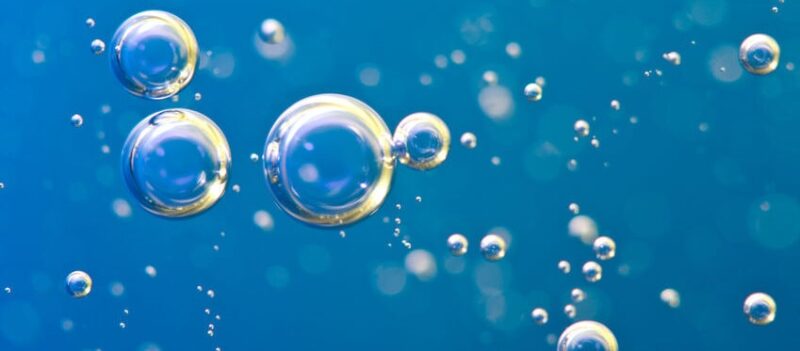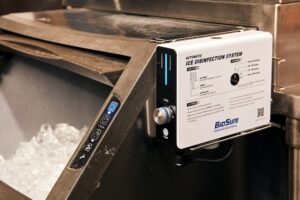Over the years, manufacturers in a variety of industries, from food and beverage, healthcare, and dentistry, have realized the importance of water quality in keeping product and service quality up to standard. However, microbes and bacteria recontamination are some of the biggest challenges that they face in keeping customers safe from contaminated water, even after installing pure water systems.

On top of this, COVID-19 has brought new challenges and a sense of urgency to ensure the places we eat, the hospitals we visit, and other businesses that rely on the use of water are properly disinfected.
Ozonated water has proven to be one of the most effective, safest, and cost-effective solutions for disinfection and sanitation. Ozone (O3) occurs naturally in the atmosphere and helps to absorb harmful UV rays from the sun. We’ve all heard of the ozone layer that helps to protect plants and animals and is essential for our survival. However, ozone can be generated for applications in a wide range of industries, including the oxidation and detoxification of wastewater, the cleaning of electronic components, and sanitation of kitchens and food treatment.

Luckily, electrolysis equipment used in electrolytic ozone generation is simple and easy to use, and as such is being adopted as an invaluable sanitizing tool in these industries.
What is electrolytic ozone?
Electrolytic ozone is created by passing an electrical current through water to break the oxygen (O2) molecules into oxygen atoms (O). The free oxygen atoms can then combine with oxygen molecules to form O3. The O3 made in this way is useful for a number of different applications and is a powerful sanitizing agent for cleaning water, water systems, and other machinery.
This method is very simple, efficient, and effective. Electrolytic ozone is especially useful for sanitizing water systems to create clean, microbe-free water. Because the ozone can be created inside the water system, contamination is kept to a minimum and can be well managed and controlled.

How electrolytic ozone is made
Electrolytic ozone can be made with electrolytic ozone generators (EOGs). These systems use two core technologies to generate ozone from water. The first technology is called direct (or inline) electrolysis. It can generate ozone from tap water and is generally used in commercial applications such as sanitizing beverage-making equipment in coffee shops, bars, and restaurants.
Proton exchange membrane (PEM) technology is another electrolytic ozone technology used in industrial applications. In this process, water is introduced to the anode side of the electrolysis cell, electrolytically decomposed, converted to ozone, and mixed with the ozone water formed in the compact cell.
Ozonated water generated through an EOG can sanitize and disinfect beverage dispensers, kitchen surfaces, dental equipment, and other environments prone to collect bacteria over time. The installation of electrolytic ozone generators is an effective way of sanitizing water. Ozone is produced from the water being treated and as such there are no contaminants, nor is there a need for the use of chemicals or additional treatment steps.
What are the main advantages of electrolytic ozone compared to traditional ozone systems?
The most notable benefit is that electrolytic systems use water to create the ozone. When it comes to ozone water disinfection, electrolytic is the industry standard.
- It’s cheaper over the long term
Hiring disinfection crews or a team of specialists to regularly disinfect a kitchen or hospital area can be expensive over time, especially when considering labor costs. Professionals in leading food and beverage companies have already adopted electrolytic ozone technologies in various critical sanitation applications over conventional chemical sanitation with the labor involved. EOG systems can automate the disinfection job while eliminating the tendency of human error. - A higher concentration of Ozone
Ozone concentration is measured in grams of ozone per standard cubic meter [g(O3)/Nm³]) or its weight percent (wt%). Traditional ozone systems produce ozone from the air with a range of 2 to 6 wt% and from oxygen with concentration from 7 wt% to over 20 wt%. Electrolytic ozone improves on this with a concentration of more than 20wt%, and BES systems can achieve up to 28 percent concentration. This purity data can mean a lot to ozone applications in water in terms of dissolution and efficiency. - Ozone is created in the water it’s disinfecting
Electrolytic ozone can be created inside the water that it is disinfecting. Therefore, no outside contamination is introduced into the system being treated, keeping the water from being recontaminated after disinfection. - Ozone dissolves in water with no by-products
There is no need to worry about excess ozone in the system and having to remove it, such as the chemical residues left over by chlorine and other chemical disinfectants - User-friendly equipment
Equipment is relatively simple and easy to use, with BES electrolytic ozone generators among the most compact and advanced in the world.
The future of ozone is electrolytic

While electrolytic ozone has been surrounded by misconceptions in the past, such as being costly, unreliable, and for use in limited applications, technological developments in electrolytic ozone have caused industry professionals to take a second look at the technology. Through BES solutions, various patented technologies have already reduced costs heavily. After more than 15 years in development, BES has designed a control system that is incredibly reliable.
BES EOGs are paving the way for a future of fewer chemicals in our food and in our environments. Electrolytic ozone is now in a mature stage of development, and an innovative solution to an age-old problem that’s bringing peace of mind to manufacturers, small business owners, and consumers alike. Whether it’s well water or ultrapure water, from California to Mongolia, as long as there are water and electricity, BES has the right EOG for the right application.
Copyright besgroups.com All Rights Reserved
Related Articles
How Ozonated Water Works
Your Questions on Ozone Water Answered
What is Ozone Water?
Ozonated Water vs UV Light Sanitation: Which is the Best Chemical-Free Sanitation?



